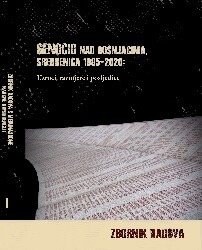Razmjere i posljedice devastirane demografske slike bosanskog Podrinja
The Scale and Consequences of the Devastated Demographic Picture of the Bosnian Podrinje
Author(s): Fikret Bečirović
Subject(s): Local History / Microhistory, Social history, Criminology, Studies in violence and power, Demography and human biology, Victimology, Transformation Period (1990 - 2010), Migration Studies, Identity of Collectives
Published by: Institut za istraživanje zločina protiv čovječnosti i međunarodnog prava Univerziteta u Sarajevu
Keywords: aggression on Bosnu i Hercegovinu; crimes; genocide; “ethnic cleansing”; homogeneous demography; migrations; depopulation; demographic consequences;
Summary/Abstract: In order to territorially expand and create a homogeneous demographic picture, “ethnic cleansing” and genocide against the non-Serb population of Podrinje was prepared first in academic, then in military circles, in our neighboring country of Serbia. The goal was to ethnically cleanse (brutally remove) the Bosniak population in every possible way from an area that covers at least fifty kilometers from the Drina River to the central part of Bosnu i Hercegovinu. The “ethnic cleansing” of that area from non-Serbs also had the intention of a “final showdown” with the undesirable, unpopular element, the remnants of the Turkish conqueror, as they labeled the Bosniak corps. Thus, the first aggressor strikes began on the eastern border and during April 1992, the entire Podrinje area was occupied, with great destruction, expulsions, imprisonment, terrorism and the cruelest crimes that reached their peak with the Srebrenica genocide. Permanent crimes and complete “ethnic cleansing” throughout the war period completely devastated the prewar demographic picture of the entire Bosnian Podrinje area. In this paper, we will analyze the causes, extent and consequences of the devastated demographic picture in 10 Podrinje municipalities, comparing the post-war census from 2013 with the pre-war census from 1991. Comparative analysis will show that war destruction, crimes, “ethnic cleansing” and genocide against Bosniaks in Srebrenica and other Podrinje municipalities caused large demographic, quantitative and qualitative changes in ethnic structure, gender, age, working age, education, culture and all other segments of life.
- Page Range: 901-919
- Page Count: 19
- Publication Year: 2021
- Language: Bosnian
- Content File-PDF

